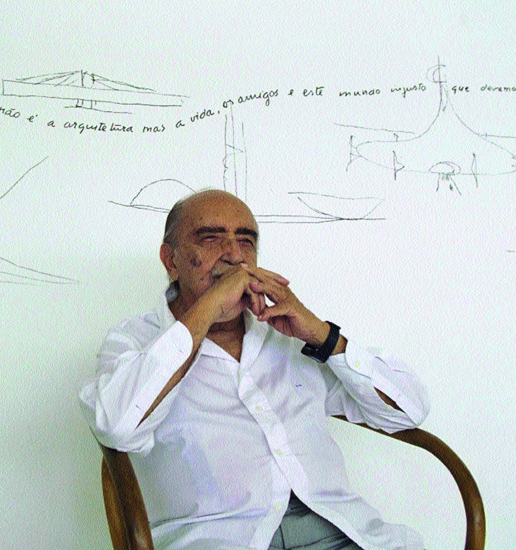[All links lead to Portuguese language pages except when otherwise noted.]
Remembered primarily as the architect who designed Brazil's capital city, Brasilia [en], and for having remained faithful to his communist ideals throughout his entire adult life, Oscar Niemeyer [en] passed away on the night of December 5 in Rio de Janeiro after succumbing to a respiratory infection. He was 104 years old.
Honored in obituaries in newspapers around the world as the man who revolutionized modern architecture by adding curves and levity to buildings and constructions in hundreds of architectural projects in Brazil and abroad. On his 100th birthday, on December 15, 2007, Global Voices revisited [en] some of the most significant creations of his life's work.

Oscar Niemeyer on the Brazilian government's official blog, under Creative Commons license (CC BY-NC-SA 2.0).
What seems pushed to the back burner in so many of the acclaims is the fact that Niemeyer defended not only his innovative architecture, but also Communism, with his atheist-humanist world view. Standing for his views was not always easy given his playing witness to the greatest changes of the twentieth century throughout his life, such as two world wars, Brazil's military dictatorship and the Cold War. His ideas cost him; he was denied visas to the US and decided to emigrate to Europe in the face of limited employment for his services in military-governed Brazil.
Career advances alone were not what agave meaning to Niemeyer, who believed that “more important than architecture is being read to protest and to take to the streets,” which he stated in the documentary “A vida é um sopro” (Life is a Breath of Air, 2007), directed by Fabiano Maciel:
Niemeyer's longevity is also something that stands out in the public's mind. The tumblr “Coisas mais novas que Oscar Niemeyer” [Things Younger Than Oscar Niemeyer”] lists everyday objects invented after the architect was born in 1907 in Rio de Janeiro. Yesterday, to mark the date of his death, the blog published one of Niemeyer's drawings with the phrase, “And now all we have left is the future.”
Niemeyer was also present on social networks under a fake profile that also poked fun at his long life. On Twitter, a number of users throughout the world have paid homage.
Tiago Bicalho (@TiagoMG13) remembers the architect's ideas:
Niemeyer desenhava certo por linhas tortas. Queria um país mais igualitário. Viveu até ver o Brasil se transformar nas mão de Lula e Dilma
Niemeyer drew straight by drawing crooked lines. He wanted a more equal country. He lived until he saw Brazil transform itself at the hands of Lula and Dilma
Gracynha Lóppez (@GracynhaLoppez) stresses his vanguard way of thinking:
Oscar Ribeiro de Almeida de Niemeyer Soares – Um dos maiores brasileiros ! Até seus pensamentos possuíam linhas com perspectivas no futuro.
Oscar Ribeiro de Almeida de Niemeyer Soares – One of Brazil's greatest ! Even your thoughts contained lines with perspectives into the future.
Meanwhile Dougal Marwick (@dougalm) [en] from Edinburgh associates Niemeyer's buildings with positive personal memories.
Walking past this with my wife en route to Le Parc des Buttes Chaumont is one of my happiest memories. RIP Mr Niemeyer. http://www.flickr.com/photos/atelier_flir/3671978939/
Gunar Almeida (@gunaralmeida) expressed cynicism at news of the centenarian architect's death:
As emissoras de TV têm falado tanto que eu tô começando a acreditar que Oscar Niemeyer morreu mesmo.
The TV stations have said so much about it that I'm starting to believe Oscar Niemeyer really did die.
And Rafa Peres (@red_bird) suggests how best to give acclaim to Oscar Niemeyer:
Pessoas q fazem homenagens pro Niemeyer… o cara era simples. Conselho: ajude a fazer um mundo mais justo q ele apoiaria.
Those of you paying homage Niemeyer… the guy was simple. A word of advice: help make the world more just because that's what he would want.
According to the United Nations Educational, Scientific and Cultural Organization (Unesco), Niemeyer also deserves the title of universal artists, according to a statement by Director-General Irina Bokova:
Apaixonado por seu trabalho, ele estava convencido de que a arquitetura tem que fazer mais do que belos edifícios: tem que contribuir para melhorar a vida na cidade como um todo e incorporar os valores de inclusão, solidariedade e cooperação.
He was passionate about work and convinced that architecture, before becoming fine arts, had to contribute concretely to living better together in the city and must embody the values of inclusion, solidarity and cooperation.






